How to Play Pai Gow Tiles
For the card and table game named Pai Gow, visit the Pai Gow Poker page.
Pai Gow Tiles has a rich history, with evidence of some form of the game dating back to the Song Dynasty in China. The game still enjoys significant success in land-based casinos. While it can be difficult to learn, the effort is worth it, as Pai Gow Tiles offers fewer hands per hour than other table games as well as the chance to gain a bit of cross-cultural knowledge on your next casino visit.
Rules
Pai Gow Tiles is played with 32 black tiles that closely resemble dominoes. The front of each tile has pips in red and white engraved on it, while the back is completely plain. Every game begins with eight starting stacks, sometimes called “woodpiles”, of four tiles each. Three dice are rolled before the tiles are shuffled and dealt face down, though these have no bearing on the hands. Originally, the house acts as the banker, after which the role can shift to other players at the table and back to the dealer again.
The player and the dealer each receive a stack of four tiles. Players then arrange their tiles into high and low hands, each with two tiles, in an effort to beat the banker/dealer. The banker then sets out their own tiles and forms high and low hands.
Player’s tiles are scored by counting the pips, then removing the tens to form a single-digit score. Should both the player’s hands beat those of the dealer or banker, they win. However, if the dealer and the player each win one hand, a push is declared.
Hands can be ranked in pairs, some of which are identical and some of which are not. Regardless, each of these combinations will beat a hand which does not contain a pair. Here is a description of the rankings from highest to lowest:
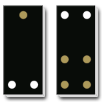
Gee Joon
a non-identical pair of tiles, the first of which contains one pip at the top and two pips at the bottom, and the second of which contains two pips at the top and four pips at the bottom. This set functions as a wild card and is the highest-ranking pair.

Teen
an identical pair of tiles, each of which has 12 pips on the face of the tile in rows of six each.
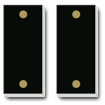
Day
an identical pair of tiles, each of which has two pips on the face of the tile, one on each end.
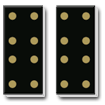
Yun
an identical pair of tiles, each of which has eight pips on the face of the tile, with a two rows of four on each.
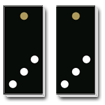
Gor
an identical pair of tiles, each of which has one pip at the top and three pips on the bottom in a diagonal line.

Mooy
an identical pair of tiles, each of which has ten pips in a box format of five.
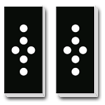
Chong
an identical pair of tiles, each of which has six pips in two diagonal rows of three.
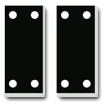
Bon
an identical pair of tiles, each of which has four pips, with two on the bottom and two on the top.

Foo
an identical pair of tiles, each of which has 11 pips on the face of the tile in a box format followed by two rows of three.

Ping
an identical pair of tiles, each of which has ten pips on the face of the tile, with a row of five on each side.
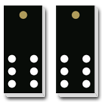
Tit
an identical pair of tiles, each of which has seven pips, with one pip at the top and six pips at the bottom in two rows of three.
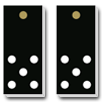
Look
an identical pair of tiles, each of which has one six pips, with a pip at the top and five pips at the bottom in a box format.
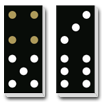
Chop Gow
a non-identical pair of tiles, both of which have nine pips in different arrangements.
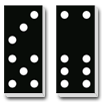
Chop Bot
a non-identical pair of tiles, both of which contain eight pips, but in different arrangements.

Chop Git
a non-identical pair of tiles, both of which contain seven pips, but in different arrangements.
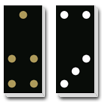
Chop Ng
a non-identical pair of tiles, both of which have five pips, but in different arrangements.
Matched pairs (hands two through 12) are collectively referred to as Bo. If a player does not have a pair with which to make a hand, the value of the two tiles is added together by counting the pips on each. For example, if you had a Day (tile with two red pips) and a Gor (tile with one red pip and three white pips, you would have a score of six. The goal is to score at least nine or as close to it as possible, with zero being the lowest-possible combination. Should you have two tiles that exceed nine, the “ten” is dropped. For instance, holding Chong and Foo gives you a score of 16, which would simply become six. This is only done when you do not have a pair.
Should both your hands have the same value while not having any rank, you must compare your individual tiles. If one holds a higher-ranking tile (such as Day or Teen), that hand has a higher value. The only exception to this rule is when both hands each have a total value of zero.
A non-ranked hand with a Gee Joon tile will see that tile work as a wildcard, becoming either three or six, depending on what would give the hand a higher value. If you have a hand with a Day or Teen tile in addition to a nine-point tile, which is one of the Chop Gow tiles, you hold a hand called a Wong, which is worth 11, not one. Similarly, a hand with the Day or Teen tiles and an eight-point tile like Yun or Chop Bot, you have a hand called a Gong which is worth ten points, not zero. These will outrank a non-paired hand.
Etiquette
Many players will opt to sit out if a player decides to bank, with some maintaining that this is done for superstitious reasons. Similarly, players can opt out of banking even when it is their turn to do so. Regardless of whether or not you believe in such things, the decision to bank is entirely up to you, though you should not take it personally if some die-hard players pull their bets.
Above all, be courteous towards other players and to the dealer, and do not comment on other players’ hands or your own hand during the course of a game. Pai Gow Tiles does not move as quickly as other table games, such as blackjack or roulette, and being patient and understanding will immensely improve your experience.
Strategy
New players may make the mistake of assuming that they do not have a pair in their four tiles because they may not be identical (in terms of layout). However, the Chop Gow, Chop Bot, Chop Chit, Chop Ng and Gee Joon pairs are not identical at all, though they do outrank non-paired hands. Make sure you can identify possible ranked hands before sitting down at the tables! If you cannot make a pair, you should try to get as close to nine as you can, or form a Wong or Gong if you can.
Pai Gow Tiles is a complex game that is difficult to learn straight away, but don’t be discouraged at the tables. You are allowed to ask the dealer questions, so long as they don’t give away information about their own hand, and the more you play, the better you will understand the game. If you are entirely new to it all, you may want to consider asking the dealer to set the tiles for you according to the house way, but this won’t help you learn more about the game or improve your technique, so don’t rely on it as a long-term strategy.
Where to Play Pai Gow Tiles
While Pai Gow Tiles is not very popular online, you can always try your luck at the Casino at the Empire in London. The game is far more common in casinos in Atlantic City and Las Vegas, so if you’re in the US, keep an eye out for Pai Gow Tiles.
Important Terms:
For more casino terminology, visit the Casino Glossary page.
